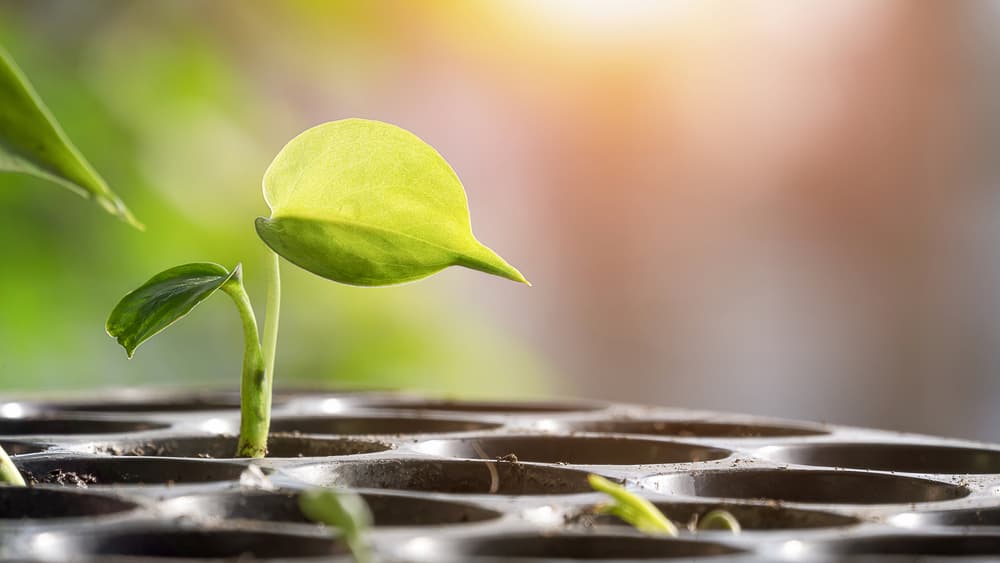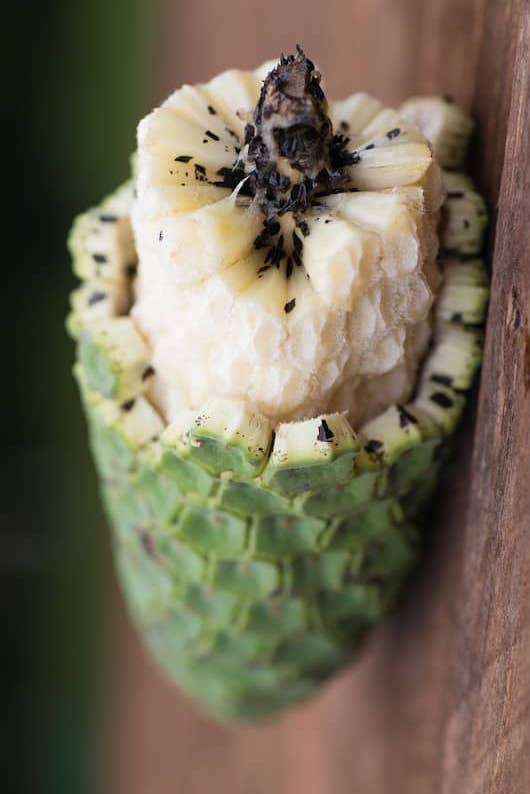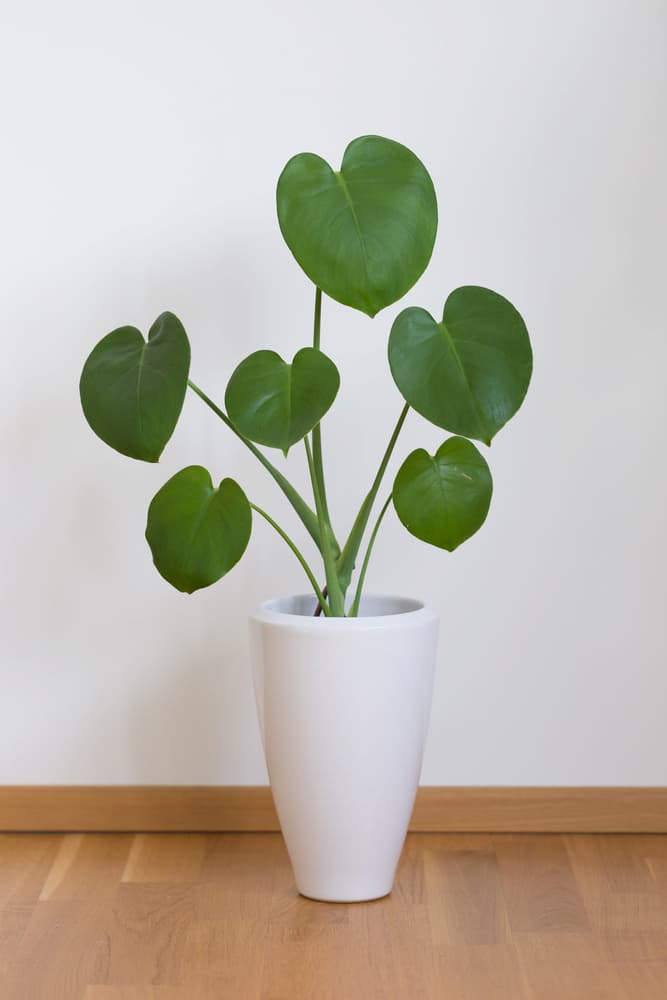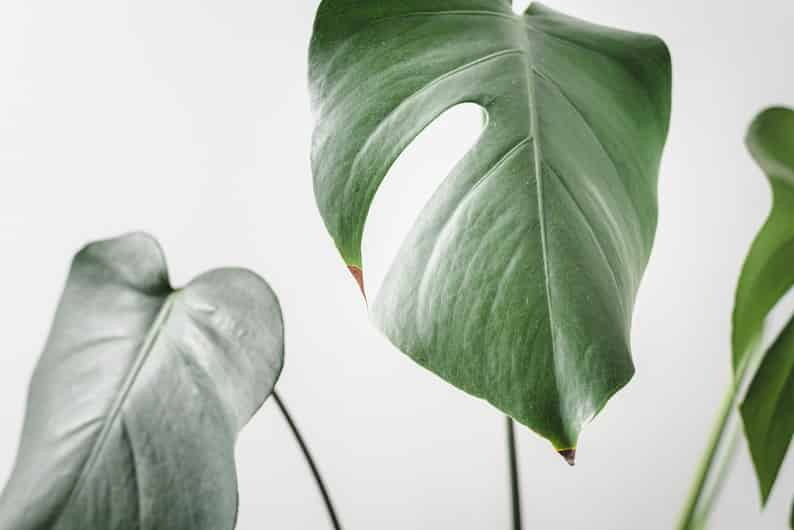One of the most fascinating parts of being a proud plant owner is that you get to watch it grow up. Knowing the Monstera growth stages can help you to better understand your plant and give it the care it needs to thrive.
Read on to learn about the major transformations that this amazing plant is going through in its lifetime!

Table of Contents
Monstera growth stages
There are three primary stages of growth for a Monstera plant. The first stage is when the plant is a seedling. The second stage is when the plant matures and begins to produce leaves. The third stage is when the plant produces flowers and fruit in its maturity.
Let’s break down each of these stages of growth so that you have an idea of what to expect from your Monstera plant in the coming years:
1. Seedling growth phase
This first phase refers to the time when a young Monstera plant is still relying on the protection and nutrients of its seed for at least partial resources. This plant will grow as a creeper on the land since it doesn’t have much strength or support to climb upwards.
The cotyledons, or seed leaves, will be the first leaves to emerge. These typically fall off after a few weeks as the true leaves of the plant begin to grow.
Related: 5 Simple Steps to Grow Monstera Deliciosa Seeds
Certain species of the Monstera plant will grow in the direction of darkness. This is known as negative phototropism and means that your plant is seeking support and potentially looking for a tree trunk or nearby branch.
During this phase, roots will grow out of the plant nodes. These roots will be thin and will grow in various lengths up to 8 inches long.

A stolon, also known as a runner, is a slender stem that grows along the ground and produces new roots from its nodes. This allows the Monstera plant to spread quickly, which can be helpful when propagating new plants.
Not all species of Monstera plants grow with stolons, which is why there are diverse growing speeds and sizes among Monstera plants.
2. Juvenile growth phase
The second phase of growth is when the plant starts to mature and produce its first set of leaves. This phase lasts as long as it takes for the plant to reach maturity, anywhere from 2 to 8 years, depending on the specific species.
This second phase usually begins around three months after germination for most species. The size, shape, and color of the leaves will depend on the specific Monstera plant that you have.

During this phase, your Monstera will start to develop aerial roots as well. These are different from the regular roots that grow in the ground, and instead, they grow out of the plant stem. They are meant to help the plant capture the moisture and nutrients in the air that it needs to grow.
In this phase, the leaves of your plant will start out as a bright green and eventually darken over time. You can expect your Monstera to grow plenty of new leaves in this time and they will also start to develop fenestrations. It takes about 4 to 6 years for a healthy Monstera plant to develop a new leaf.
Find out more: How Long Do Monsteras Take To Grow (and How to Speed It Up)?
3. Mature fruition growth phase
In its mature years, the Monstera plant produces flowers and fruit. The flowers are small and white, and they grow in clusters. Some of the flowers will produce fruit in the plant’s natural conditions or in a well-monitored home growing setup.

These Monstera fruits create seeds that can be used to propagate new Monstera plants. The fruits of a mature Monstera plant are green and have a white, fleshy interior. They are similar in size and shape to a banana. They are edible when fully ripe.
While the flowers and fruit are not necessary for the plant’s survival, they are an indication that your plant is healthy and doing well. You can expect to see these features anywhere from eight to ten years after germination.
Monstera fenestration stages
Fenestrations are the large, gaping holes that form in the leaves of a mature Monstera plant. The Monstera fenestration stages see the leaf first begin as a solid shape, then develop side slits. Finally, it eventually develops primary, secondary, and tertiary midrib holes.
There are many reasons why the Monstera plant forms fenestrations, but the most likely explanation is that it helps the plant cope with high winds and heavy rains. The holes act as little windows that allow wind and water to pass through the leaves without damaging them.
Fenestrations are a beautiful feature of the mature Monstera plant, and they’re something to look forward to as your plant grows. Here’s what you can expect in each stage of fenestration development:
1. Solid growth phase
In the first stage of fenestration, there isn’t much to see at all. At this point, the Monstera leaves are solid and don’t have any slits or holes. While it doesn’t look like much is happening at this point, the plant is actually laying the groundwork for fenestrations to form later on.

2. Side slit growth phase
In the second stage, you’ll start to see slits form on the sides of the leaves. These slits are usually about an inch or two long and don’t go all the way through the leaf. This is the beginning of fenestration development and it’s an exciting time to watch your plant grow.
Find out more: When Do Monstera Leaves Split?
3. Midrib growth phase
Finally, in the third stage, the primary, secondary, and tertiary holes will start to form in the midribs of the leaves. These holes are larger than the side slits and go all the way through the leaf.

4. Full growth phase
In the fourth and final stage, the fenestrations are fully developed, and the leaves look like they have been punched full of holes. This is the most visually striking stage of fenestration development, and it’s also when the plant’s leaves have reached maturity.
How to encourage fenestration in Monstera plants
If you want to encourage fenestration in your Monstera plant, you can make a few adjustments to your plant care routine. The most important thing is to make sure that your plant is getting enough light. Fenestrations are more likely to form in leaves that are exposed to strong diffused sunlight.
Another important note is to make sure that your plant is getting enough water. Fenestrations are also more likely to form in leaves that are well-hydrated.
Finally, make sure that your plant is getting enough nutrients. A lack of nutrients can cause sluggish growth, meaning the plant won’t have enough energy to form its fenestrations.
